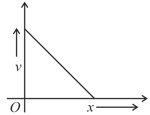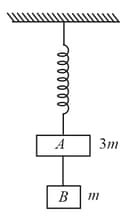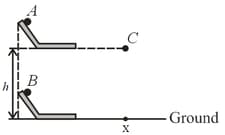State and explain Aristotelian law of motion.
Important Questions on Laws of Motion
Two blocks and are placed one over the other on a smooth horizontal surface. The maximum horizontal force that can be applied on lower block , so that and move without separation is . The coefficient of friction between and is


The given graph shows the variation of velocity with position for a particle moving along a straight line

Which of the following graph shows the variation of acceleration with position
A maximum of force can be applied on a block, down the incline, that would still not move the block which is placed on a rough inclined plane as shown in the figure. The maximum external force up the inclined plane that does not move the block is . The coefficient of static friction between the block and the plane is


A rectangular frame of some mass has to be suspended symmetrically by two mass-less strings of equal length on two supports. It can be done in one of the three following ways as shown in below figures. The tension in the strings will be

(i) The strong nuclear force binds protons and neutrons in a nucleus.
(ii) The strong nuclear force is about times the electromagnetic force in strength.
(iii) The weak nuclear force is the weakest of all the four fundamental forces.
(iv) The range of the weak nuclear is about
The correct statement(s) is (are)
The length of a metal wire is when the tension in it is and is when the tension is The natural length of the wire is:
Three balls, and are released and all reach the point (shown in the figure). Balls and are released from two identical structures, one kept on the ground and the other at height from the ground as shown in the figure. They take time and respectively to reach (time starts after they leave the end of the horizontal portion of the structure). The ball is released from a point at height vertically above and reaches in time . Choose the correct statement.

A spherical body of mass starting from rest acquires a kinetic energy of at the end of second. The force acted on the body is _____ .

